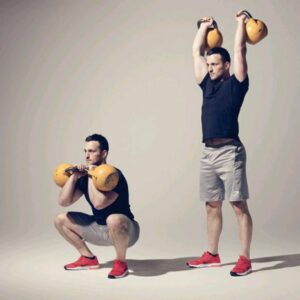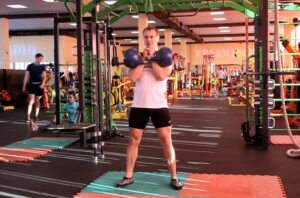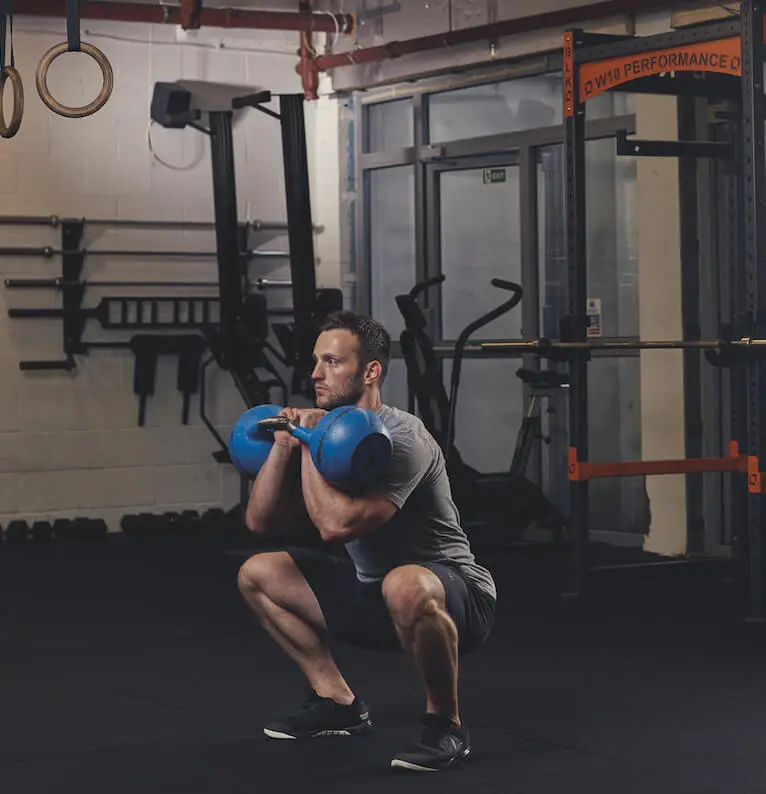KETTLEBELL THRUSTER: THE COMPLETE GUIDE
How to perform the kettlebell thruster?
The kettlebell thruster is a strength and conditioning kettlebell exercise that combines a deep squat with an explosive overhead arm thrust. It is a complex movement that involves several muscle groups and requires precise coordination to be performed correctly.
Definition of the kettlebell thruster
The kettlebell thruster is a variation of the CrossFit “thruster” movement performed with an Olympic bar. This version uses two kettlebells rather than a weight bar to add resistance and instability to the exercise.
The movement begins with a front squat with two kettlebells held in rack position. Then, using the thrusting force of the legs, the kettlebells are propelled upwards until they are held above the head with the arms outstretched. The kettlebells are then lowered back into the rack position to repeat the movement.

Objectives and advantages of the kettlebell thruster
- The kettlebell thruster is a complete exercise that involves several muscle groups, including the legs, glutes, back, shoulders, triceps and abdominals. One of the main advantages of this exercise is that it develops pushing strength and power throughout the body, particularly in the legs and shoulders.
- The kettlebell thruster is also an excellent exercise for improving mobility, stability and coordination : it helps to strengthen stabilizing muscles and improve posture and balance.
- Finally, the kettlebell thruster is an excellent exercise for burning calories and boosting metabolism. It can be integrated into a high-intensity training program to improve fitness and lose weight.
Muscles involved in the kettlebell thruster
The kettlebell thruster is a complete exercise that involves several muscle groups. Here are the main muscles worked and the secondary muscles involved during this exercise.
The main muscles worked
Quadriceps: The quadriceps are the muscles located at the front of the thigh. During the kettlebell thruster, they are used during the squat phase. The quadriceps are the main muscles responsible for knee extension.
Glutes: The glutes are used during the squat and leg extension phase. The glutes are the main muscles responsible for hip extension.
Shoulders: The shoulder muscles are exercised during the overhead kettlebell phase. The muscles of the shoulder include the deltoid, trapezius and rotator muscles.
Triceps: The triceps are the muscles at the back of the arm and are used during the overhead kettlebell phase. The triceps are the main muscles responsible for elbow extension.
Secondary muscles involved
Hamstrings: The hamstrings are the muscles at the back of the thigh. They are involved during the squat phase and help to flex the hip and knee.
Abdominals: The abdominal muscles are involved throughout the movement to stabilize the load. The abdominals are the main muscles responsible for stabilizing the trunk.
Back: The back muscles are used throughout the exercise to maintain good posture. The muscles of the back include the erector spinae, trapezius and rhomboid muscles.
Calves: The calf muscles are used during the leg extension phase. The calf muscles are the main muscles responsible for plantar flexion.
The kettlebell thruster is therefore a complete exercise that solicits several muscle groups at the same time. It is effective in strengthening the muscles of the legs, glutes, shoulders and triceps, while improving strength, coordination and overall fitness.

How to perform the kettlebell thruster with two kettlebells
The kettlebell thruster is an effective exercise that combines the benefits of the squat and jerk. Here’s how to do the kettlebell thruster with two kettlebells:
Starting position
Grab a kettlebell in each hand and perform a shoulder press to place them on your shoulders (in a rack position). The kettlebells should be in contact with your shoulders and your elbows should be bent. Keep your back straight, your shoulders back and your eyes straight ahead.
Squat descent
Bend your knees and lower yourself into a squat position. Keep your heels on the ground and your feet flat. Lower until your thighs are parallel to the floor, or in full flexion if you’re mobile enough. Keep your back straight and your eyes straight ahead. Breathe in during this phase.
Leg and arm extension
Push on your legs to straighten up while using the strength of your arms to push the kettlebells over your head. Your arms should be straight with your elbows close to your head. Push your hips forward and lock your knees. Breathe out during this phase.
Descending kettlebells
Lower the kettlebells by bending your elbows. The kettlebells should come down in contact with your shoulders. Keep your back straight and your eyes straight ahead. Bend your knees to return to the squat position and repeat the movement.
You can increase the difficulty by using heavier kettlebells or by increasing the number of repetitions. You can also add the kettlebell thruster to your training routine by using different variations, such as the kettlebell thruster with a single kettlebell.
The kettlebell thruster with two kettlebells is an excellent exercise for strengthening leg, back and shoulder muscles while improving coordination and strength. With the right technique and regular practice, you can enjoy the benefits of this exercise to improve your overall fitness.
Other articles that might interest you:
- Kettlebell swing
- Kettlebell clean
- Kettlebell snatch
- Kettlebell squat
- Kettlebell press
- Kettlebell deadlift
- Kettlebell clean and jerk

